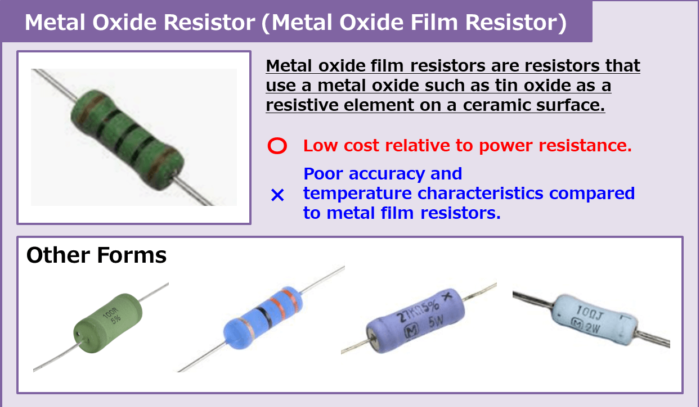
Metal oxide resistors are vital components in the realm of electronics, serving as indispensable elements in circuit design across an extensive array of applications. Renowned for their stability, precision, and high-power handling capabilities, these resistors have secured a prominent place in modern electronics due to their exceptional electrical properties and reliability.
Composition and Structure
Metal oxide resistors are typically composed of a ceramic core, primarily consisting of a blend of metal oxides. Common materials utilized in these resistors include tin oxide, ruthenium oxide, and other metal oxides, often combined with a ceramic substrate. This composition contributes to their outstanding electrical characteristics.
The resistive element is formed by depositing a thin film of metal oxide on the ceramic substrate, which is then coated with a protective layer to shield it from environmental factors like moisture, heat, and mechanical stress.
Essential Properties
Exceptional Stability: Metal oxide resistors exhibit remarkable stability in resistance values over an extensive range of temperatures and frequencies.
Low Noise Emission: These resistors provide low noise performance, making them suitable for high-precision applications in sensitive circuits.
Precision and Accuracy: Offering precise and consistent resistance values, metal oxide resistors are crucial for maintaining circuit integrity and accuracy.
High Power Dissipation: They have the ability to dissipate higher power levels compared to several other types of resistors, making them suitable for applications requiring high power ratings.
Reliability: With robust construction and high-quality materials, metal oxide resistors are known for their long-term reliability.
Applications across Industries
Electronics and Telecommunications
Metal oxide resistors find extensive use in electronic devices, including amplifiers, filters, and signal processing circuits. Their stability and accuracy ensure optimal performance in signal conditioning and transmission systems.
Power Electronics
In power electronics, these resistors are employed in power supplies, voltage regulation, and motor control circuits. Their high power handling capability and stability under load make them crucial components in these applications.
Automotive Industry
The automotive sector utilizes metal oxide resistors in various systems such as engine control units (ECUs), lighting, and safety systems. Their ability to withstand temperature variations and high reliability make them suitable for automotive applications.
Industrial Automation
In industrial settings, these resistors are used in control systems, instrumentation, and machinery where stability, accuracy, and reliability are crucial.
Advantages and Limitations
Advantages
Stability: Metal oxide resistors offer excellent stability in resistance values over time and operating conditions.
Accuracy: Their precision and consistent resistance values ensure reliability in critical circuits.
High Power Handling: They can handle higher power levels compared to several other resistor types.
Low Noise Emission: Their low noise performance makes them ideal for applications requiring minimal interference.
Limitations
Physical Size: They might be larger in size compared to certain other types of resistors with similar power ratings.
Cost: Metal oxide resistors can be relatively more expensive due to their high-quality materials and intricate manufacturing processes.
Evolution and Future Trends
Ongoing research and development in materials science and semiconductor technology aim to further enhance the performance of metal oxide resistors. Efforts concentrate on reducing their physical footprint while maintaining or improving their power handling capabilities and accuracy. Additionally, innovations to make them more cost-effective without compromising their performance will drive advancements in this field.
Conclusion
Metal oxide resistors stand as essential components in electronic circuitry, offering stability, accuracy, and high power handling capabilities across diverse industries. Their reliability and precision make them indispensable in critical electronic systems, from telecommunications to industrial automation. While they might have limitations in terms of size and cost, their exceptional electrical properties and consistent performance continue to solidify their importance in modern electronics.
As technology advances, ongoing research and development endeavors aim to refine these resistors, ensuring they remain at the forefront of innovation and continue to meet the evolving needs of electronic applications. The journey of metal oxide resistors reflects not just their current significance but also their promising future in the landscape of electronic components.
